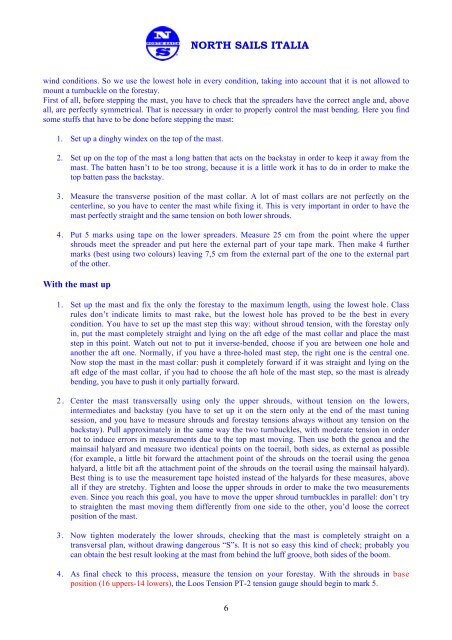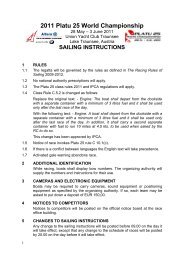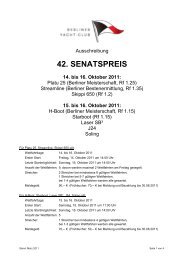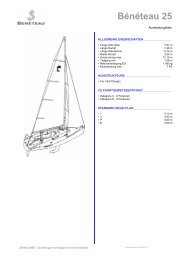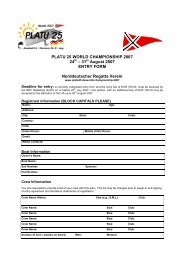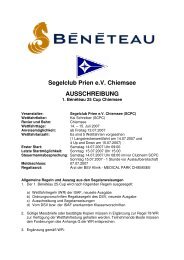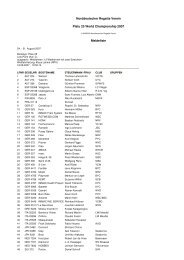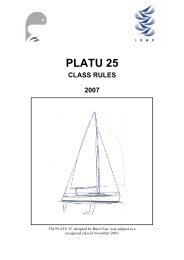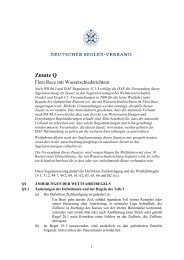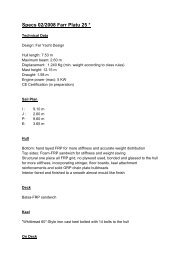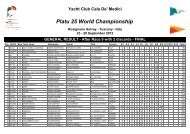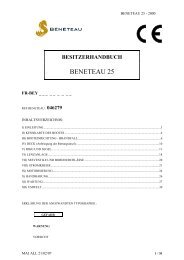NORTH SAILS ITALIA Bénéteau 25 O.D. Tuning Guide ... - Platu 25
NORTH SAILS ITALIA Bénéteau 25 O.D. Tuning Guide ... - Platu 25
NORTH SAILS ITALIA Bénéteau 25 O.D. Tuning Guide ... - Platu 25
Create successful ePaper yourself
Turn your PDF publications into a flip-book with our unique Google optimized e-Paper software.
<strong>NORTH</strong> <strong>SAILS</strong> <strong>ITALIA</strong><br />
wind conditions. So we use the lowest hole in every condition, taking into account that it is not allowed to<br />
mount a turnbuckle on the forestay.<br />
First of all, before stepping the mast, you have to check that the spreaders have the correct angle and, above<br />
all, are perfectly symmetrical. That is necessary in order to properly control the mast bending. Here you find<br />
some stuffs that have to be done before stepping the mast:<br />
1. Set up a dinghy windex on the top of the mast.<br />
2. Set up on the top of the mast a long batten that acts on the backstay in order to keep it away from the<br />
mast. The batten hasn’t to be too strong, because it is a little work it has to do in order to make the<br />
top batten pass the backstay.<br />
3. Measure the transverse position of the mast collar. A lot of mast collars are not perfectly on the<br />
centerline, so you have to center the mast while fixing it. This is very important in order to have the<br />
mast perfectly straight and the same tension on both lower shrouds.<br />
4. Put 5 marks using tape on the lower spreaders. Measure <strong>25</strong> cm from the point where the upper<br />
shrouds meet the spreader and put here the external part of your tape mark. Then make 4 further<br />
marks (best using two colours) leaving 7,5 cm from the external part of the one to the external part<br />
of the other.<br />
With the mast up<br />
1. Set up the mast and fix the only the forestay to the maximum length, using the lowest hole. Class<br />
rules don’t indicate limits to mast rake, but the lowest hole has proved to be the best in every<br />
condition. You have to set up the mast step this way: without shroud tension, with the forestay only<br />
in, put the mast completely straight and lying on the aft edge of the mast collar and place the mast<br />
step in this point. Watch out not to put it inverse-bended, choose if you are between one hole and<br />
another the aft one. Normally, if you have a three-holed mast step, the right one is the central one.<br />
Now stop the mast in the mast collar: push it completely forward if it was straight and lying on the<br />
aft edge of the mast collar, if you had to choose the aft hole of the mast step, so the mast is already<br />
bending, you have to push it only partially forward.<br />
2. Center the mast transversally using only the upper shrouds, without tension on the lowers,<br />
intermediates and backstay (you have to set up it on the stern only at the end of the mast tuning<br />
session, and you have to measure shrouds and forestay tensions always without any tension on the<br />
backstay). Pull approximately in the same way the two turnbuckles, with moderate tension in order<br />
not to induce errors in measurements due to the top mast moving. Then use both the genoa and the<br />
mainsail halyard and measure two identical points on the toerail, both sides, as external as possible<br />
(for example, a little bit forward the attachment point of the shrouds on the toerail using the genoa<br />
halyard, a little bit aft the attachment point of the shrouds on the toerail using the mainsail halyard).<br />
Best thing is to use the measurement tape hoisted instead of the halyards for these measures, above<br />
all if they are stretchy. Tighten and loose the upper shrouds in order to make the two measurements<br />
even. Since you reach this goal, you have to move the upper shroud turnbuckles in parallel: don’t try<br />
to straighten the mast moving them differently from one side to the other, you’d loose the correct<br />
position of the mast.<br />
3. Now tighten moderately the lower shrouds, checking that the mast is completely straight on a<br />
transversal plan, without drawing dangerous “S”s. It is not so easy this kind of check; probably you<br />
can obtain the best result looking at the mast from behind the luff groove, both sides of the boom.<br />
4. As final check to this process, measure the tension on your forestay. With the shrouds in base<br />
position (16 uppers-14 lowers), the Loos Tension PT-2 tension gauge should begin to mark 5.<br />
6


